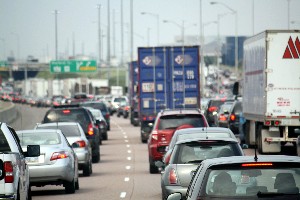A computer science professor at Massachusetts Institute of Technology proposed a mathematical model for monitoring traffic flow in cars to prevent temporary traffic jams that could be implemented with technology already in some vehicles. Berthold Horn, a faculty member in MIT’s Computer Science and Artificial Intelligence Laboratory, discussed his algorithm earlier this month at IEEE’s Conference on Intelligent Transportation Systems in the Netherlands.
Horn notes that there are many models available, some dating back decades, to predict traffic jams on freeways, but few solutions for actually reducing their occurrence. The model in this case applies to situations where highway traffic is moving smoothly, only to be suddenly slowed for apparently none of the usual reasons, like a broken-down vehicle or accident. He says these situations, called traffic flow instabilities, happen often on routes near Boston, which he experiences first-hand.
The model presented by Horn uses data already gathered by equipment in some high-end vehicles with radar or laser sensors to measure the speed and distance of the car immediately ahead. However, the proposed algorithm would also collect data on the vehicle behind as well as ahead of it. If a car can stay roughly half-way between the vehicles ahead and behind, it would not need to slow down as abruptly should the driver ahead step on the brakes.
This ability to monitor and adjust the distance between cars both ahead and behind mitigates the effect of one car braking, then causing a cascade of abrupt braking down the line of vehicles previously traveling at highway speeds. “It’s kind of a chaotic system,” says Horn in a university statement. “It has positive feedback, and some little perturbation can get it going.”
Horn’s algorithm adapts a calculation called a damped-wave equation, applied to phenomena such as waves rippling through heavy liquids that die out over a distance, as well as techniques from control theory for stabilizing these phenomena. The algorithm incorporates traffic flow data including reaction times of drivers, desired speed, and how quickly drivers can accelerate to achieve that desired speed when space opens up in the lane ahead.
He tested the algorithm with data from Interstate-93 north of Boston, which showed the adjustments made by drivers incorporating the algorithm in cars’ cruise-control systems could smooth out these temporary back-ups under a range of conditions. The problem, says Horn, is the algorthm assumes most cars on the highway have that kind of system, and currently it’s available only as an option on high-end vehicles.
To have a realistic chance of being generally adopted, the algorithm would need to be implemented with less expensive and widely used automotive technology. One such technology is digital cameras that are inexpensive and increasingly found on family cars to monitor drivers’ blind spots. Horn says two cameras that measure distance and relative velocity could provide those data. But as Horn notes, “The disadvantage of that is, well, two cameras, plus alignment. If they ever get out of alignment, you have to recalibrate them.”
It turns out much of Horn’s research is in the field of computer vision, and his research group published a paper earlier this year on calculating distance and velocity with a single camera. These data are entered into a ratio known in transportation research as time-to-contact, which as the name implies, measures the risk of an imminent collision. Horn is looking into whether the traffic flow instability algorithm can be run with data derived from time-to-contact rather than direct speed and distance values.
Read more:
- Cell Phone, GPS Data Identify Urban Traffic Jam Sources
- Traffic Intersection Study Pinpoints Stoplight Danger Zone
- Algorithm Predicts Auto Traffic Intersection Violators
- Simulation Improves Safety at Traffic Intersections
* * *


 RSS - Posts
RSS - Posts
You must be logged in to post a comment.